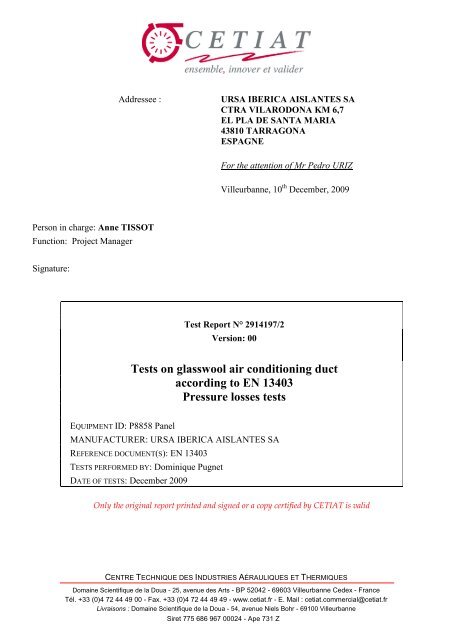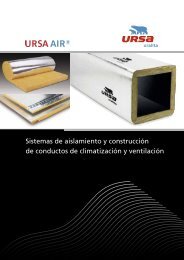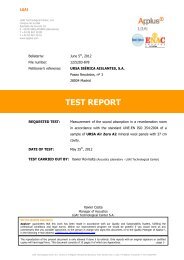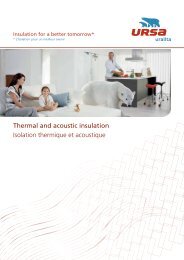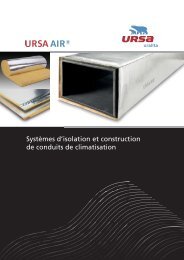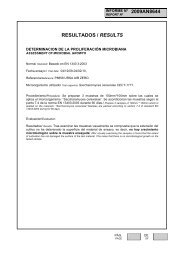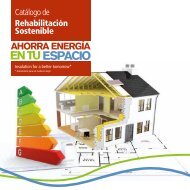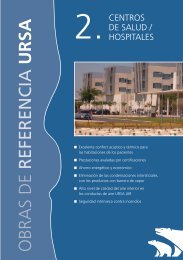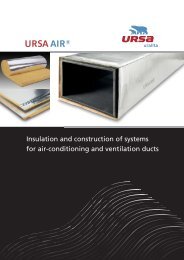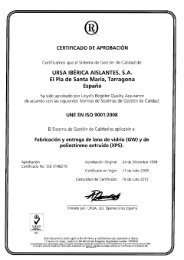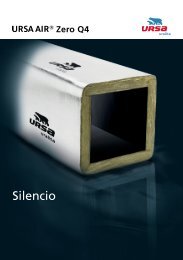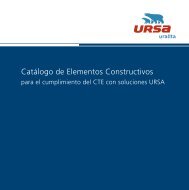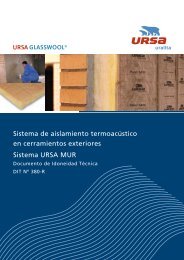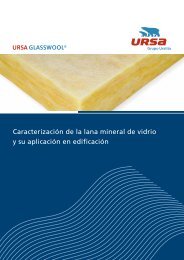Tests on glasswool air conditioning duct according to EN ... - Ursa
Tests on glasswool air conditioning duct according to EN ... - Ursa
Tests on glasswool air conditioning duct according to EN ... - Ursa
Create successful ePaper yourself
Turn your PDF publications into a flip-book with our unique Google optimized e-Paper software.
Addressee :URSA IBERICA AISLANTES SACTRA VILARODONA KM 6,7EL PLA DE SANTA MARIA43810 TARRAGONAESPAGNEFor the attenti<strong>on</strong> of Mr Pedro URIZVilleurbanne, 10 th December, 2009Pers<strong>on</strong> in charge: Anne TISSOTFuncti<strong>on</strong>: Project ManagerSignature:Test Report N° 2914197/2Versi<strong>on</strong>: 00<str<strong>on</strong>g>Tests</str<strong>on</strong>g> <strong>on</strong> <strong>glasswool</strong> <strong>air</strong> c<strong>on</strong>diti<strong>on</strong>ing <strong>duct</strong><strong>according</strong> <strong>to</strong> <strong>EN</strong> 13403Pressure losses testsEQUIPM<strong>EN</strong>T ID: P8858 PanelMANUFACTURER: URSA IBERICA AISLANTES SAREFER<strong>EN</strong>CE DOCUM<strong>EN</strong>T(S): <strong>EN</strong> 13403TESTS PERFORMED BY: Dominique PugnetDATE OF TESTS: December 2009Only the original report printed and signed or a copy certified by CETIAT is validC<strong>EN</strong>TRE TECHNIQUE DES INDUSTRIES AÉRAULIQUES ET THERMIQUESDomaine Scientifique de la Doua - 25, avenue des Arts - BP 52042 - 69603 Villeurbanne Cedex - FranceTél. +33 (0)4 72 44 49 00 - Fax. +33 (0)4 72 44 49 49 - www.cetiat.fr - E. Mail : cetiat.commercial@cetiat.frLivrais<strong>on</strong>s : Domaine Scientifique de la Doua - 54, avenue Niels Bohr - 69100 VilleurbanneSiret 775 686 967 00024 - Ape 731 Z
Test Report N° 2914197/2Versi<strong>on</strong> : 00Cus<strong>to</strong>mer : URSA IBERICA AISLANTES SAThe signed original report cancels all results and draft documents previously submitted.Each updated versi<strong>on</strong> of the report supersedes all previous <strong>on</strong>es.All void copies must be returned <strong>to</strong> CETIAT or destroyed. We draw your attenti<strong>on</strong> of errorsincurred by keeping a void copy.Versi<strong>on</strong> Date Nature of changeModifiedpages00 10/12/2009 First editi<strong>on</strong>Results of reports are the exclusive property of the cus<strong>to</strong>mer and CETIAT prohibits their distributi<strong>on</strong> <strong>to</strong> thirdparties without prior written c<strong>on</strong>sent.Any commercial use of the name CETIAT or of results is subject <strong>to</strong> CETIAT’s prior c<strong>on</strong>sent.This report may be reproduced <strong>on</strong>ly in its entirety.The reports written by CETIAT are valid <strong>on</strong>ly for the equipment provided for the test in the specificc<strong>on</strong>diti<strong>on</strong>s under which the test was run.Informati<strong>on</strong> c<strong>on</strong>cerning the measurement equipment used for the tests is kept in CETIAT’s archives.The use of these results for designing equipments using this material must take in<strong>to</strong> account manufacturing<strong>to</strong>lerances and real operating c<strong>on</strong>diti<strong>on</strong>s. CETIAT cannot be held liable for such use of these results.The formulas or codes used <strong>to</strong> predict either the operati<strong>on</strong> of a device in c<strong>on</strong>diti<strong>on</strong>s other than those usedin the test or the characteristics of similar devices of different dimensi<strong>on</strong>s are based <strong>on</strong> the state ofknowledge at the time the results were delivered and are subject <strong>to</strong> change. The results obtained throughthese formulas or codes are given as an indicati<strong>on</strong> <strong>on</strong>ly.The original copy of the report is given <strong>to</strong> the cus<strong>to</strong>mer and a certified copy is kept at CETIAT.2/10
Test Report N° 2914197/2Versi<strong>on</strong> : 00Cus<strong>to</strong>mer : URSA IBERICA AISLANTES SAC O N T E N T S1. INTRODUCTION...........................................................................................................42. SUMMARY OF THE RESULTS...................................................................................5APP<strong>EN</strong>DIX 1 - DESCRIPTION OF THE TESTS .........................................................6APP<strong>EN</strong>DIX 2 - DETAILED RESULTS.........................................................................93/10
Test Report N° 2914197/2Versi<strong>on</strong> : 00Cus<strong>to</strong>mer : URSA IBERICA AISLANTES SA1. INTRODUCTIONThe objective of the tests was <strong>to</strong> characterise the linear pressure losses of an <strong>air</strong> c<strong>on</strong>diti<strong>on</strong>ing<strong>duct</strong> made in insulati<strong>on</strong> <strong>duct</strong>boards, reference P8858. The report 2914197/1 of the 24 th ofNovember deals with the results of previous tests made <strong>on</strong> same pro<strong>duct</strong> (erosi<strong>on</strong> andemissi<strong>on</strong> of particles, resistance against pressure, <strong>air</strong> leakage fac<strong>to</strong>r and <strong>air</strong>tightness class).Figure 1: tested pro<strong>duct</strong>Summary of the results is in part 2.The descripti<strong>on</strong> of the tests is in APP<strong>EN</strong>DIX 1 -.The detailed are in APP<strong>EN</strong>DIX 2 -.The tests were made by Mr Dominique PUGNET.4/10
Test Report N° 2914197/2Versi<strong>on</strong> : 00Cus<strong>to</strong>mer : URSA IBERICA AISLANTES SA2. SUMMARY OF THE RESULTSThe Figure 2 presents the values of the linear pressure losses <strong>according</strong> <strong>to</strong> <strong>air</strong> velocity, for thestandard c<strong>on</strong>diti<strong>on</strong>s (20°C, 101325 Pa), and for a secti<strong>on</strong> of 300 mm × 300 mm. The linearpressure losses are due <strong>to</strong> the roughness of the inner surface of the <strong>duct</strong>boards and theturbulence possibly created by the links between each board.Linear pressure losses <strong>according</strong> <strong>to</strong> <strong>air</strong> velocity (rho = 1,2 kg/m3)Linear pressure losses (Pa/m)14,012,010,08,06,04,02,00,00,0 5,0 10,0 15,0 20,0Air velocity (m/s)Figure 2 : Linear pressure losses <strong>according</strong> <strong>to</strong> <strong>air</strong> velocity, for P8858 reference,300 mm × 300 mm5/10
Test Report N° 2914197/2Versi<strong>on</strong> : 00Cus<strong>to</strong>mer : URSA IBERICA AISLANTES SAAPP<strong>EN</strong>DIX 1 -DESCRIPTION OF THE TESTSThe aim of the tests is <strong>to</strong> determine the linear pressure losses of the <strong>duct</strong>, due <strong>to</strong> the roughnessof the inner surface of the <strong>duct</strong>boards and the turbulence possibly created by the links betweeneach board.The pressure losses tests were made using the samples built for the previous tests :- 2 m + 2 m L-shaped assembly, secti<strong>on</strong> of 300 mm × 300 mm,- straight <strong>duct</strong> of 7 modules of 1,16 m of length and secti<strong>on</strong> of 300 mm × 300 mm,- Straight <strong>duct</strong> of 2 modules of 1.16 m of length and secti<strong>on</strong> of 300 mm × 300 mm.The hydraulic diameter of the <strong>duct</strong> is then 300 mm.Upstream of the L – shaped assembly are the fan and the <strong>air</strong>flow rate measurement device.The static pressure difference is measured between two points placed <strong>on</strong> the straight part ofthe assembly. The distance between these two points is 7.0 m, and includes 6 links betweenthe boards.3 mPoint 17 mPoint 22.9 mFigure 3 : View of the tests assembly6/10
Test Report N° 2914197/2Versi<strong>on</strong> : 00Cus<strong>to</strong>mer : URSA IBERICA AISLANTES SAThe first static pressure tap is 3 m behind the 90° - bend, that is <strong>to</strong> say 10 hydraulic diameters.The static pressure is measured with a Pi<strong>to</strong>t probe in the centre of the <strong>duct</strong>. Before themeasurements, the homogeneity of the static pressure was checked for the <strong>air</strong> velocity of 12m/s, at 9 different points in the same secti<strong>on</strong>.Figure 4 : Positi<strong>on</strong> of the Pi<strong>to</strong>t Probe, point 1The static pressure difference between the point 1 and the point 2 is measured for different<strong>air</strong>flow rates in the <strong>duct</strong>. For each point of the curve, the following parameters are measured :- Atmospheric pressure,- Air temperature,- Airflow rate,- Relative humidity,- Static pressure difference.As the average <strong>air</strong> velocity is the same at point 1 and at point 2, the static pressure differencecorresp<strong>on</strong>ds <strong>to</strong> the pressure losses (the dynamic pressure is the same at point 1 and at point 2).7/10
Test Report N° 2914197/2Versi<strong>on</strong> : 00Cus<strong>to</strong>mer : URSA IBERICA AISLANTES SAThe results are then used <strong>to</strong> determine :- The Reynolds number Re,- The fricti<strong>on</strong> coefficient λ,- The pressure losses <strong>according</strong> <strong>to</strong> the <strong>air</strong>flow rate in standard c<strong>on</strong>diti<strong>on</strong>s (<strong>air</strong>temperature = 20°C, Pressure = 101325 Pa).With :ρVDhRe = Andµ∆P=λ× L ×Dh12× ρ × V2Re: Reynolds number, adimensi<strong>on</strong>alρ : absolute density, in kg/m 3V: Average <strong>air</strong> velocity in the <strong>duct</strong>, in m/sD h : hydraulic diameter of the <strong>duct</strong>, in mµ : dynamic <strong>air</strong> viscosity, in Pa.sλ : fricti<strong>on</strong> coefficient, adimensi<strong>on</strong>alL: length of the <strong>duct</strong>, in m8/10
Test Report N° 2914197/2Versi<strong>on</strong> : 00Cus<strong>to</strong>mer : URSA IBERICA AISLANTES SAAPP<strong>EN</strong>DIX 2 -DETAILED RESULTSMeasurementsAirflow rate TemperatureAtmospheric Dew point Pressurepressure temperature lossesQv T Patm Td ∆Pm 3 /h °C Pa °C Pa1 1948 20,4 99232 10,4 9,62 2583 20,3 99240 10,4 16,23 3234 20,4 99250 10,5 24,34 3886 20,6 99272 10,5 33,95 4545 21,1 99285 10,5 45,66 5212 21,3 99300 10,6 58,37 5859 21,9 99316 10,6 72,48 6232 22,2 99326 10,6 81,6Calculati<strong>on</strong>s for the test c<strong>on</strong>diti<strong>on</strong>sAir velocityPressure Absolute Dynamic Reynolds fricti<strong>on</strong> Linear pressurelosses density viscosity number coefficient lossesV ∆P ρ µ Re λ ∆P/Lm/s Pa kg/m 3 Pa.s - - Pa/m1 6,01 9,6 1,172 1,81E-05 1,2E+05 0,0195 1,42 7,97 16,2 1,172 1,81E-05 1,5E+05 0,0186 2,33 9,98 24,3 1,172 1,81E-05 1,9E+05 0,0178 3,54 11,99 33,9 1,172 1,82E-05 2,3E+05 0,0173 4,85 14,03 45,6 1,170 1,82E-05 2,7E+05 0,0170 6,56 16,09 58,3 1,169 1,82E-05 3,1E+05 0,0165 8,37 18,08 72,4 1,167 1,82E-05 3,5E+05 0,0163 10,38 19,24 81,6 1,166 1,82E-05 3,7E+05 0,0162 11,7Calculati<strong>on</strong>s for the standard c<strong>on</strong>diti<strong>on</strong>s (20°C, 101325 Pa)fricti<strong>on</strong> Absolute DynamicPressureAir velocitycoefficient density viscositylossesλ ρ µ V ∆P- kg/m 3 Pa/s m/s Pa1 0,0195 1,2 1,81E-05 5,87 9,42 0,0186 1,2 1,81E-05 7,78 15,83 0,0178 1,2 1,81E-05 9,74 23,74 0,0173 1,2 1,81E-05 11,69 33,05 0,0170 1,2 1,81E-05 13,63 44,26 0,0165 1,2 1,81E-05 15,62 56,47 0,0163 1,2 1,81E-05 17,49 69,78 0,0162 1,2 1,81E-05 18,58 78,39/10
Test Report N° 2914197/2Versi<strong>on</strong> : 00Cus<strong>to</strong>mer : URSA IBERICA AISLANTES SALambda coefficient0,0250Lambda coefficient (-)0,02000,01500,01000,00500,00001,0E+051,0E+06Reynolds number Re (-)Figure 5 : Fricti<strong>on</strong> coefficient <strong>according</strong> <strong>to</strong> Reynolds numberLinear pressure losses <strong>according</strong> <strong>to</strong> <strong>air</strong> velocity (rho = 1,2 kg/m3)Linear pressure losses (Pa/m)14,012,010,08,06,04,02,00,00,0 5,0 10,0 15,0 20,0Air velocity (m/s)Figure 6 : Linear pressure losses <strong>according</strong> <strong>to</strong> <strong>air</strong> velocity10/10


